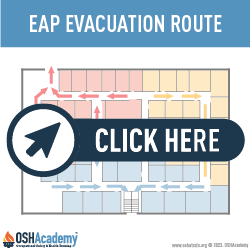Exit Routes
Two or more exits are required if the number of employees, size of the building, or arrangement of the workplace will not allow employees to evacuate safely. Exit routes must be located as far away from each other as practical in case one exit is blocked by fire or smoke.
Exception: One exit route is allowed if the number of employees, building size, occupancy, or layout lets everyone evacuate safely during an emergency.
Many employers make maps using floor diagrams. These maps show where exit routes are, as well as the locations of assembly points and important equipment like fire extinguishers, first aid kits, and spill kits. Exit routes should:
- be clearly marked and well-lit;
- be wide enough for everyone who needs to leave;
- unobstructed and clear of obstacles and debris; and
- not put people at extra risk while evacuating.
When you make drawings of evacuation routes and exits, put them up where all employees can easily see them. Check out OSHA's Interactive Floorplan Demonstration.
Knowledge Check Choose the best answer for the question.
1-5. Why must exit routes be located as far away from each other as practical?
You forgot to answer the question!

